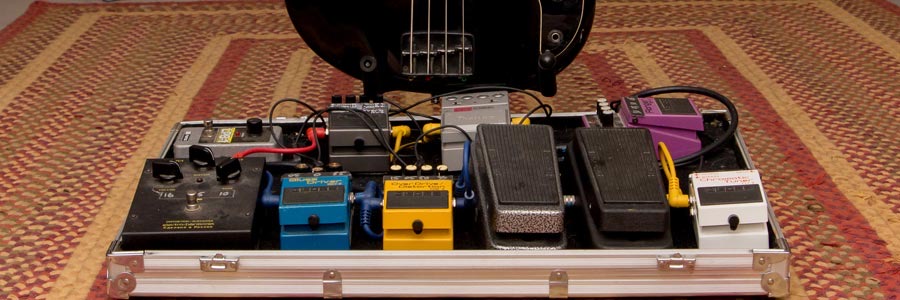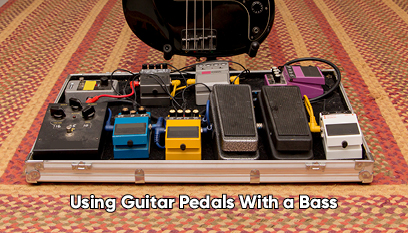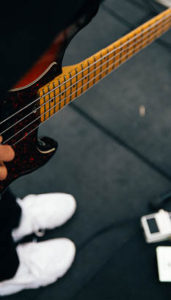
Effects pedals are more commonly associated with guitar than bass. It is not unusual to see a lead guitarist stomping on a dozen pedals to create elaborate solos while the bass player is holding down the low end with a relatively clean tone and limited effects. This, combined with the fact that several manufacturers offer effects pedals specifically for bass, naturally leads to the question: Can guitar pedals be used with a bass?
Yes, you can use effects pedals made for guitar with a bass. The pedal can’t tell that you’re playing a bass – it just modifies the signal it gets. You may lose some of the low frequencies — and it might sound awful! — but technically it will work.
Being able to use guitar pedals with a bass is handy if you play both instruments, or you’re a guitar player who wants to dabble in bass without investing in a second set of pedals.
(If you’re just beginning your guitar or bass adventures, you may also want to check out Do Beginners Need Guitar Pedals? and Should You Learn Guitar or Bass First? For tips on using guitar pedals with a fiddle — including how to make the fiddle sound like an organ! — check out my discussion with The Dustbowl Revival’s fiddle wizard, Connor Vance.)
Which Guitar Pedals Definitely Won’t Work With a Bass?
Just like in the 90s “classic” movie Airheads when the Lone Rangers asked, “Who would win in a fight: Lemmy or God?” this is a trick question.
Taste in guitar tone often boils down to the simple question, “What do you like?” Your Mileage May Vary is basically a catchphrase when talking about different applications for pedals in different signal chains. There just isn’t one correct answer.
While many bass players tend to steer clear of time-based effects like reverb and delay, as they prefer to have their low end cut through dry, many fretless players tend to apply these effects to accentuate the fretless tone. It’s all about what you’re looking for in any given situation.
Distortion, fuzz, overdrive, and other kinds of dirt pedals meant for guitars can sound like mush (and many other four-letter words) with a bass. This is not a hard and fast rule, though — it all depends on the tone you’re going for. If you like the way your ProCo RAT or Ibanez Tube Screamer sounds with your bass, go ahead and use it.
As a personal example, a staple recording tone for my college band when we were looking for dirty bass was to use my father’s 1980s vintage Peavey Patriot bass by way of an old yellow DOD Overdrive pedal into a stout Peavey TKO 85 bass amp. Was that a sexy look in the early 2000s? Hell no. But we dug the way it sounded, so that’s what we did.
If you’re out there shopping for a dirt pedal meant for guitar that you can also use with a bass, look for ones with a blending knob. This will help you more finely control the tone so you can keep the powerful lower frequencies clear and just color the upper end.
Guitar Effects That Tend to Sound Great With a Bass
Compressor
Compressors are much more commonly used with bass than with guitar. A compressor effectively makes the loud notes quieter and the quiet notes louder. This evens out the bass signal, allowing it to sit better in the mix. Some players see a compressor for the bass as essential, while others prefer to let the sound engineer do the compressing from the front-of-house position. I would recommend that a gigging musician strongly consider a compressor as a live sound insurance policy. Some nights you’ll have a sound engineer who knows exactly how to mix a band, and other nights you’ll be lucky if the “sound guy” is more than just the bartender who knows how to turn the system on and the jukebox off.
Any compressor pedal will have a control for the amount of compression it applies to the signal and some kind of volume or output control, which determines how much of that compressed tone is passed down the signal chain.
More advanced compressors will also offer controls for tone to help you better color your compressed signal, in addition to controls such as attack and blend. Attack determines how quickly the compression effect takes place. The blending knob gives you the option of mixing your original signal with your compressed signal to achieve your desired mix.
It is important to choose a quality compressor, unless you are intentionally trying to make your bass sound like a different instrument. The initial attack of sound from playing a note and its subsequent decay are the hallmarks of a plucked/struck instrument like a guitar or a bass. Since a compressor fundamentally changes those features, you need to experiment to find one that can do its job without making your P-Bass sound like a bagpipe.
Chorus
Chorus pedals are popular with many players because they help create a dreamy effect. I have a love/hate relationship with chorus pedals because my dad’s instinct is to throw chorus on everything (because he was a gigging musician in the 80s). I think too much chorus, especially on acoustic guitar, sounds really dated, but it’s useful in certain applications. For example, chorus can help thicken up a bass tone to provide some movement and variation between parts of a song.
Envelope Filter
If you’re looking to get that funk feel, an envelope filter is the way to go. It is sometimes called an autowah. You’ve certainly heard envelope filters if you’re a fan of the 90s funk/metal tones of Primus and the Red Hot Chili Peppers. Even bands like Muse have used envelope filters to add some color to the mix.
My personal feeling is that the 90s tone is a bit played-out and its worship can lead to overindulgence, conjuring up images of dreadlocked jam-band players who go on extended bass “journeys” while I go get a beer at the bar. I would rather hear an envelope filter deployed for some classic Parliament or to add some flavor to Stevie Wonder covers.
The best part about trying out envelope filters is that you can walk into a store and tell the sales clerk that you’re looking for a Moogerfooger. How sweet is that? (Check out Tips for Testing Out Guitar Pedals in a Store for more practical guidance for gear shopping.)
Bass Synths and Octave Pedals
Sometimes you DO want to make you bass sound like a different instrument while still holding down the low end of the song. If that’s the case, look no further than a bass synth pedal or an octave pedal.
A bass synth pedal can help you get wild low-end sounds that you never thought were possible from a bass guitar. It can also help you get some subtler features, since it offers you so many options for blending the voicing and the filters. These units can help you add tones similar to a classic Moog synth without the trouble of learning how to play the keyboard.
If you can’t swing a bass synth (they can be quite pricey at around $300 each), an octave pedal can help you get a fatter bass tone at a more reasonable price – but unfortunately you’ll miss out on the more adventurous features.
Effects Pedals Made for Bass
Several manufacturers make pedals specifically for bass guitar, and I encourage you to check them out and see what you think. Some bass players actually prefer the guitar versions of pedals to their bass counterparts, and the only way you’ll know for sure is to try them out.
Wait, Won’t The Bass Signal Destroy Guitar Gear?
A very common fear about mixing bass equipment and guitar equipment is catastrophic damage. I’ve seen people jump across the room and nearly tackle someone about to plug a bass into a guitar rig, screaming that “It will blow up!” That’s not really the case.
A guitar amplifier will not blow up just because you plug a bass into it. All the amplifier knows is that it is getting signal. It doesn’t know what it is coming from. Back when I worked for a high-tech company in high school, I plugged an old Hewlett Packard sweep signal generator into an amp and messed around with it for an hour, and there was no damage to my amp or the speaker.
Getting Back to Lemmy
It’s all about having reasonable expectations of what you’ll get, which brings me back to Lemmy. The classic rumor was that Lemmy was so badass that he played bass direct through a Marshall stack.
These rumors are part true. Lemmy did have a stack of Marshalls. He famously remarked that Marshall amps and speakers have stood behind him on every continent– but they were bass amps and cabs!
Side note: I can find no evidence of Lemmy performing on Antarctica, but I’ll give him a pass on the geography lesson since he’s Lemmy and I am not.
While many cite his unique tone, which was very mid-range heavy, as evidence that he was using guitar amps, it is just not true. He was in fact using some unique 1970s Marshall bass equipment, combined with his unorthodox playing style and undeniable swagger.
Your guitarist’s Marshall stack is meant to handle a certain range of tones, and the low B of your 5 string bass is not one of them. At low volume it may sound okay, but if you plug it in and crank it up thinking you’ll achieve Lemmy-like results, you will be very disappointed.



